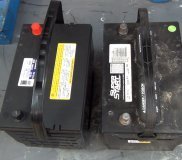Your battery should not be defective after only three years. Have you tried charging it at a slow rate first to see if it really is bad or just run down? Have you measured its voltage? Loose or dirty cable connections are a much better suspect. Also, follow the smaller positive battery wire to the under-hood fuse box and be sure that connection is clean and tight.
Use an inexpensive digital voltmeter to measure the voltage right across the battery's two posts, and tell me what you find.
There is no way I would ever trust a used battery from a private party. They are getting rid of it for a reason. One better alternative is to visit a larger salvage yard. They will have batteries from cars that are just a few months old. My friend has a body shop where he specializes in rebuilding smashed one and two-year-old Dodge trucks. Mine was a year old and had only 4,200 miles when I bought it. There are all kinds of these vehicles, many with less than 1,000 miles, and most are bought by the salvage yards. The yards in my city sell these almost-new batteries for $25.00.
Another alternative that few people know about is to visit a battery store and ask for a "reconditioned" battery. Your choices are limited to the selection they have at the moment. Ford is famous for using odd-ball-size batteries so a lot of people have to go back to the dealership. These uncommon sizes will show up eventually at the battery stores, but you may not find one on their reconditioned shelf. The people there will be able to tell you the physical dimensions and method of bolting it into the car. You can also figure this out yourself with a tape measure. Measure the three dimensions, observe which post is in which corner, and how it is held in place.
Reconditioned batteries could be those that have been sitting on the shelf too long, but more commonly they will be those a do-it-yourselfer bought, took home, and it did not solve the problem, so they returned it. Most stores will not consider those as "new", so they sell them at a discount. My favorite local store sells these for $35.00. I have even bought some huge deep cycle batteries there that I use to run radio displays at old car show swap meets.
For the electrical specifications, most manufacturers install the smallest battery that will do the job, so anything you find for sale later will be better. The exception is when you are replacing a replacement battery on an older car. That one is likely already a lot stronger than what came from the factory, so it is not unexpected that the next new one might be smaller than what is being replaced now. There are two standardized ratings used to compare batteries to each other. The less-common is "cranking amps", (CA). The more accurate and more common rating is "cold cranking amps", (CCA). Most batteries have that number listed on the sticker on top. If, for example, yours is listed as a "600 CCA", any battery with a higher number will be stronger and/or will last longer before it is run drained. There is a limit to how much lead they can fit into the case size they are limited to, so the strongest car batteries will have CCA ratings around 750 to 825. It is important to understand that higher numbers do not mean the engine will crank any faster. The biggest advantage to a higher CCA rating is that battery will have an easier time cranking a really cold engine in winter.
I should also point out that a few people mistakenly believe a car battery is like a flashlight battery, and when it is drained, it must be replaced. In fact, all car batteries can only crank an engine for a total of a few minutes before it runs drained. That would ruin it after only a few weeks. It is the charging system that runs the car's electrical system, and it recharges the battery right after it cranked the engine. If not for a properly-working charging system, your new battery would be run drained in an hour or two of normal driving, and much less if the head lights or heater fan was on.
Monday, January 15th, 2018 AT 2:33 PM




